Autonomous vehicles are real. Combination of different sensors (cameras, radars or LiDAR) allow vehicles to take its environment (weather, other vehicles, pedestrian, etc.) into account and therefore accelerate, turn, break autonomously.
Automotive simulation has become essential in order to accelerate the developments safely.
Advanced driving assistance systems (ADAS) are more and more complex and numerous on each vehicle. Today, millions or billions of kilometers of driving and a variety of known and unknown situations are required in order to test and validate all the systems in a vehicle. Particularly, the driving assistance systems for night drive and projector control are really challenging to evaluate and validate.
Like regular ADAS systems, the projectors on a vehicle are also getting smarter and more complex and embed advanced functionality such as glare free high beam or matrix beam in order to display pictograms on the road using the projectors.
The evaluation of the performance of a projector is a huge challenge for car and equipment manufacturers for many reasons:
- As on track tests are only possible during the night, the experiments are even more dangerous.
- The track tests are highly dependent on the weather conditions.
- Setting up the experiment is very time consuming.
- And more.
These reasons implies that iterations between conception teams and tests teams are often very long. Between two tests sessions, it is required to:
- Modify and improve the models.
- Tests the models before producing the prototype.
- Wait for winter to arrive in northern countries where the night is longer before going to the test tracks.
- And more.
AVSimulation, aware about these challenges, propose the Headlights Packs.
With this pack, headlight simulation in SCANeR is possible through a physics-based rendering engine and a set of tools that enable the analysis of simulation results in real-time as well as through post processing. This solution is integrated in SCANeR studio product allowing the users to benefits from others strength such as: environment and scenario creation, access to specific materials (with BRDF), etc. and combine headlight simulation with other domain such as sensors, vehicle dynamics or human factor research.
Headlight simulation allows engineers to execute tests on digital proving grounds regardless of the weather conditions with much shorter iteration loops with the development team. Only one final prototype is required with simulation.
A reliable and trustworthy rendering
SCANeR headlight solution gives access to a computational tool chain that takes into account physical properties of the light propagation in order to achieve a reliable and realistic rendering. Each element of the scene has its own material and its own reflection properties. Simulation gives control over weather conditions and reproducibility for very specific condition such as fog or simulation with wet road.
Wet Road rendering in SCANeR studio
Fog rendering in SCANeR studio
A quicker and safer validation campaign
SCANeR solution allows to quickly set up complexes situations that would have been very difficult and dangerous to run on real test track, with or without human in the loop. To help engineer with the evaluation of projectors, SCANeR provides analyzing tools such as aiming walls, isolux curves, luminance sensors, etc.
For each experiment, the driver can also be “removed” and success criteria can be defined with a virtual driver (lateral and longitudinal commands can be easily emulated to your own values). This allows the reproduction of specific maneuvers and exploration of defined experiments. It also allows the evaluation and comparison of projector performance reliably on top of the human assessment.
Aiming wall
Isolux curve
Smart projectors, a cutting-edge technology
One of the biggest challenges within smart projector development is to determine the area which can be illuminated without blinding other drivers. Engineers can reproduce the optical configuration of a vehicle and test it in SCANeR. The intensity and orientation of each light source can be adjusted in real time using the sensors output, thus allowing the users to interface, test and validate smart projectors.
Pixel lighting SCANeR studio
To sum up, lighting simulation has become a must-have in automotive simulation for many reasons:
Experts are able to make critical decision on technology choices based on simulation results. |
Written by Denis Thy.
If you would like to have more information and be contacted by one of our sales representatives, contact us.


